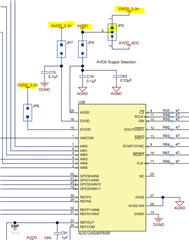Other Parts Discussed in Thread: TPSM82912, LM27762,
Tool/software:
Hello,
I am currently looking into power supplys for the ADS124S08. I am new to hardware design and I feel kind of lost with all the things I have to consider
After some investigation this is what I have learned so far:
- DC/DC converters are efficient but have a ripple voltage output, which can be mitigated with a LDO-regulator.
- Using LDO-regulators only is inefficient and introduces heat into the system.
- AVDD and DVDD should be low noise and low ripple, as both can introduce noise into the measurement
My desgin has the following specifications:
- The design must drive the adc and a mcu. The external voltage I am expecting ranges from 6 to 12 V.
- Both mcu and adc need a digital voltage supply of 3.3V
- The analog voltage supply should be bipolar +- 2.5 V.
- The adc measurement rate is slow but high precision(1 -100 Hz)
- I do have limited pcb-space, so a small footprint is a must.
I am thinking about using a DC/DC converter such as TPSM82912 for converting from 6 - 12 V to 3.3 V for DVDD of the ADC and for the DVDD of the MCU.
For AVDD/AVSS I want to use the LM27762 as bipolar source for AVDD/AVSS with Vout of +- 2.5 V.
The idea is, that with the TPSM82912, I dont need an extra LDO-Regulator for DVDD and can drive both ,the adc and the mcu.
With the Power Designer I get a footprint of 93 mm2 for the TPSM, which is kind of large, but ok, if I don't need a lot of other parts.
What do you think?
- Is the TPSM82912 suitable for drivng the DVDD of the ADC and the mcu?
- What other aspects do I need to consider?
Thank you for your time and answer
Regards
Johannes


